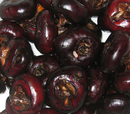Showing Food Chinese water chestnut
| General Information | |||||||||||
|---|---|---|---|---|---|---|---|---|---|---|---|
| Name | Chinese water chestnut | ||||||||||
| Scientific Name | Eleocharis dulcis | ||||||||||
| Description | The Chinese water chestnut (Eleocharis dulcis; synonyms E. equisetina, E. indica, E. plantaginea, E. plantaginoides, E. tuberosa, E. tumida), more often called simply the water chestnut, is a grass-like sedge grown for its edible corms. The water chestnut is actually not a nut at all, but an aquatic vegetable that grows in marshes, underwater in the mud. It has tube-shaped, leafless green stems that grow to about 1.5 metres. The water caltrop, which is also referred to by the same name, is unrelated and often confused with the water chestnut. The small, rounded corms have a crisp white flesh and can be eaten raw, slightly boiled, or grilled, and are often pickled or tinned. They are a popular ingredient in Chinese dishes. In China, they are most often eaten raw, sometimes sweetened. They can also be ground into a flour form used for making water chestnut cake, which is common as part of dim sum cuisine. They are unusual among vegetables for remaining crisp even after being cooked or canned, because their cell walls are cross-linked and strengthened by certain phenolic compounds, like oligomers of ferulic acid. This property is shared by other vegetables that remain crisp in this manner, including the tiger nut and lotus root. The corms are rich in carbohydrates (about 90 percent by dry weight), especially starch (about 60 percent by dry weight), and are also a good source of dietary fiber, riboflavin, vitamin B6, potassium, copper, and manganese. If eaten uncooked, the surface of the plants can transmit Fasciolopsiasis. | ||||||||||
| Primary ID | FOOD00332 | ||||||||||
| Picture |  | ||||||||||
| Classification | |||||||||||
| Group | Vegetables | ||||||||||
| Sub-Group | Other vegetables | ||||||||||
| Taxonomy | |||||||||||
| Superkingdom | Eukaryota | ||||||||||
| Kingdom | Viridiplantae | ||||||||||
| Phylum | Streptophyta | ||||||||||
| Class | Magnoliopsida | ||||||||||
| Order | Poales | ||||||||||
| Family | Cyperaceae | ||||||||||
| Genus | Eleocharis | ||||||||||
| Species | dulcis | ||||||||||
| Variety | Not Available | ||||||||||
| External Links | |||||||||||
| ITIS ID | 506699 | ||||||||||
| Wikipedia ID | Chinese_water_chestnut | ||||||||||
| Composition | |||||||||||
| Compounds |
Processing... | ||||||||||
| Macronutrients |
Processing... | ||||||||||
| References | |||||||||||
| Content Reference | — Duke, James. 'Dr. Duke's Phytochemical and Ethnobotanical Databases. United States Department of Agriculture.' Agricultural Research Service, Accessed April 27 (2004). — U.S. Department of Agriculture, Agricultural Research Service. 2008. USDA National Nutrient Database for Standard Reference, Release 21. Nutrient Data Laboratory Home Page. | ||||||||||